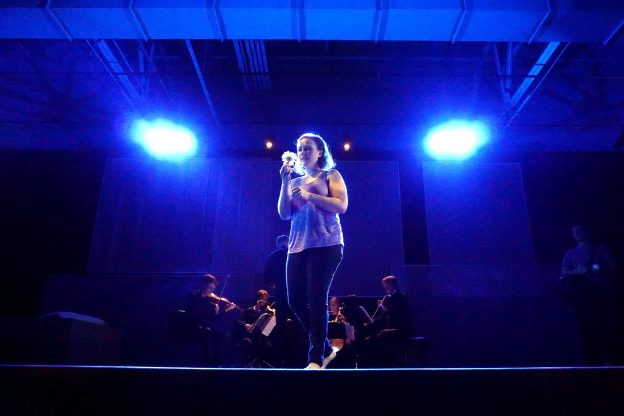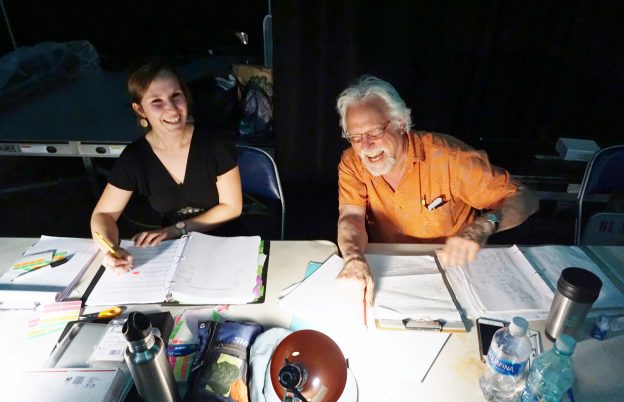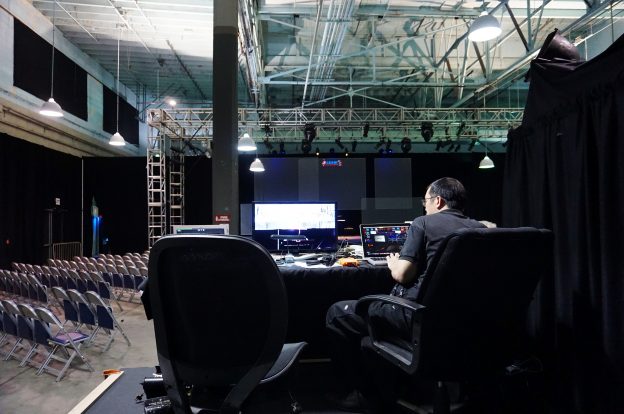
#HOTVillage: As One Lighting
It takes a bunch of talented, skilled people that you never see or hear to pull these things off. There’s a lot going on that the audience doesn’t see. That’s what we are. We’re the people you don’t see. And we don’t want to be seen. We want to have these transitions happen and appear like magic, to some extent. Being the support role is what we do.” – HOT Director of Production Rob Reynolds
Because producing an opera truly takes a village, #HOTVillage gives you an intimate look at one piece of production for each HOT opera. In this piece, HOT’s principle lighting and set designer Peter Dean Beck took us behind the scenes of As One for a look at the new production’s lighting.
Lighting in “A World Where People Sing”

Stage Manager Madeline Levy (Left) and Lighting Designer Peter Dean Beck (Right) have a laugh while preparing lighting cues for HOT’s production of As One.
Peter Dean Beck has designed scenery and lighting for more than 350 productions around North America and Asia. Almost a third of those were HOT productions.
“I’ve been with [the Hawaii Opera Theatre] a long, long time,” Peter said. “I started here in 1986, and this is my 32nd season with the company. I’ve always done this. It’s the only career I’ve ever had.”
Peter didn’t always know that opera production would be his career, though. But he did have an awareness of the behind-the-scenes aspects of theater productions since his youth. Peter’s grandfather was a screenwriter, so he grew up with firsthand experiences of the world behind the curtain.
But it wasn’t until he attended Oberlin College that Peter had the opportunity to be a part of an opera production. He then went to graduate school at the New York University Tisch School of the Arts. His first work in opera was Verdi’s La Traviata in North Carolina in 1977.
“That was an education, let me tell you,” Peter said. “I began to understand that opera can be dramatic and theatrical. It’s more than just singing.”
Designing lighting and sets for an opera was very different from lighting a play, a dance piece, or even a musical, he learned. Unlike in a movie, where a camera is able to tell an audience where to look, lighting must do this in opera. And in opera, sets have to be able to accommodate the strict tempo of the music. For instance, if a chorus has four bars to enter the stage, they need to be able to maneuver within a set in that amount of time. Lastly, in opera, the designer of lighting and sets must also consider each singer’s ability to be heard within their placement on the stage.
“I’ve always maintained that a world where people sing shouldn’t look like a world where people speak,” Peter said. “Singing rather than speaking moves us into a more lyrical and abstracted dimension.”
Over the course of his lifetime in work with scenic and lighting designing, Peter has worked on many repeat operas. He has designed for ten productions of both Madame Butterfly and The Magic Flute. His most recent work with HOT was designing the lighting and scenery for this season’s production of Bizet’s Carmen. He will also be back for HOT’s next season production, Donizetti’s Daughter of the Regiment.
But there are still operas he’s never worked on before. One of those pieces is HOT’s new production, As One.
As One is a chamber opera for a cast of two singers and a string quartet. There are no costume changes and minimal set pieces and props. Additionally, HOT is performing the piece in an all-new venue, Pier 10 at the Aloha Tower Terminal. All of these factors make for a unique lighting design challenge.
“It’s always interesting to discover a new piece,” Peter said.
Peter’s work in designing sets and lighting always begins with an in-depth knowledge of the production itself. He learns the music’s timing and the libretto’s story so that he can accommodate these with his vision. The next step is designing for the performance space.
“Working in the Blaisdell Concert Hall is a lot different from working in Pier 10,” Peter said. “Pier 10 presented major challenges. It’s not a theatre, so we had to make it one. There’s a lot of hidden effort when you play in a place like that.”
Peter’s crew erected three lighting “trusses,” or metal overhead supports for lighting, over the stage in Pier 10. They then hung 44 individual lights from the trusses and focused them in the direction they would need to point.

A member of the crew prepares for show time
After that, Peter sat down with As One’s Director and Stage Manager to set “lighting cues,” — timed recordings of how the lights will look during each part of the opera. In As One, there are about 80 of these cues. Before the production begins, an electrician does one last check that all lights are working, and then it’s show time.
Some of Peter’s favorite lighting moments in the production come in the third part of the piece. In stark contrast with the opera’s earlier settings, like classrooms and cafes, the third part is set in nature, in Norway. The story’s protagonist, Hannah, describes her experiences of rowing a boat and searching the night sky for the Northern Lights.
“It goes to a very deep color there that we haven’t seen before,” Peter said. “It has this mystical, cosmic quality instead of the harsh white light of being indoors.”
Many people think of lighting as a nuts-and-bolt, technical job, Peter expressed. But to him, designing lighting is much more than that. It’s poetry.
“A performer uses him or herself as their medium as an artist. I use stuff,” he said.
“I try to make poetry out of stuff.”
